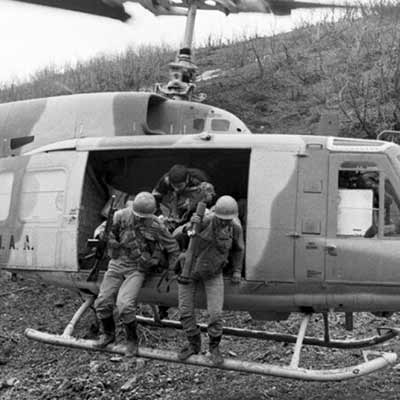Battles
Operation Nasr 2
Maryam Akhoundian
177 Views
Operation Nasr 2 was carried out on June 3, 1987, with the code-name “Ya Hussain (as) Mazloom” on the western slopes of Meimak Heights (Ilam Province).[1]
The Meimak Heights were of great military significance due to their vantage point, allowing for effective surveillance and fire control over the surrounding areas within Iraqi territory, particularly along the Mandali-Zarbatiyeh-Badreh connection route. After occupying these heights, the Iraqis named them “Saif Saad” in memory of Saad ibn Abi Waqqas’s victory over the Iranians. However, in the early months of the war, Iran reclaimed most of the Meimak Heights during Operation Khwarazm, leaving only an area known as “Naf Meimak” in the northern and southern Meimak Heights under enemy control. Consequently, Operation Nasr 2 was designed and executed to defeat the enemy, recapture Meimak, and disturb Iraq’s military concentration on other fronts.
In this operation, a gendarmerie battalion from Shahid Taheri Base, an infantry battalion, and an armored cavalry battalion accompanied the 40th Sarab Brigade of the Islamic Republic of Iran Army Ground Forces.[2]
On June 3, 1987, Iranian forces advanced within one kilometer of the Ney-Khazar Outpost, putting it under heavy fire. During this assault, two artillery battalions of the Baathist army were also targeted and destroyed.
Recognizing the activities of the Iranian Army forces who had positioned in the newly captured heights and gained control over Mandali, Zarbatiyah, and Badreh, the enemy launched several counterattacks. However, the Iranians resisted and destroyed many Iraqi light weapons, machine guns, mortars, and several tanks, and forced the enemy to retreat.[3]
By 8 AM, the Iranian forces had captured peaks 400, 404, and 396, seizing 20 square kilometers of Iraqi territory (the Halaleh region) and advancing as far as one kilometer of the Ney-Khazar border outpost, keeping it under observation. During the operation, over 800 Iraqi soldiers were killed or wounded, and several were captured. The 1st and 2nd Battalions of the 4th Brigade of the 22nd Division, a commando battalion, a tank company, and the 361st and 663rd artillery battalions also were destroyed. In addition, ten tanks and dozens of light and medium weapons were seized.[4]
The day after the operation, Iraqi forces tried to recapture the three peaks in the Meimak region, but their heavy counterattack was repelled. At 4:15 AM, the Iraqi army reorganized the remaining forces of the defeated 22nd Division and launched another counterattack to reclaim the liberated areas. However, this assault was repelled by the Iranian Army’s heavy artillery fire in the initial minutes, forcing the enemy to retreat with casualties. During this failed counterattack, 14 Iraqi tanks and armored personnel carriers were destroyed, over 250 soldiers were killed or wounded, and 5 were captured.[5]
On June 4th, the Algerian press reported on the operation and the liberation of three key heights.[6]
Two days after the operation began, on June 5, 1987, Iraq launched two additional counterattacks in Meimak. The first occurred at 5 AM and the second in the late hours of June 5th, but both were repelled by Iranian forces.[7]
On June 5, 1987, during the Friday Prayer sermon, Hojatoleslam Hashemi Rafsanjani highlighted the strategic importance of this area, saying: “Even when the 1975 Algiers Agreement was signed and the Shah ceded part of these heights—while the Iraqis, in return, agreed to concede the Shatt al-Arab (Arvand Rud) to Iran—some believed that this location was of greater significance than what he got”.[8]
On June 9th, the Iranian Army Ground Forces continued carrying out Operation Nasr 2, capturing two more heights in western Meimak and liberating an additional seven square kilometers of Iraqi land thereby bringing the total liberated area to 30 square kilometers.[9]
On June 18, 1987, at 8:27 AM, the Iranian Air Force fighter jets bombed enemy troop gatherings and positions in Meimak.[10]
In this attack, the forces engaged in the first front successfully achieved the objectives. However, on the second front, the enemy lines did not break, and the Ney-Khazar and Halaleh areas remained under Iraqi control. Consequently, the Iranian Army decided to conduct another operation (Operation Nasr 6 launched on August 1, 1987) to clear the remaining parts of Meimak from enemy forces and liberate the occupied parts of Halaleh.[11]
[1] Rouzshomar-e Jang-e Iran va Araq (Chronology of the Iran-Iraq War), Ketab-e Chehel-o-Nohom: Tasvib-e Qatnameh 598 (Volume 49: Adoption of Resolution 598), by Alireza Lotfollahzadegan, Tehran: Markaz-e Asnad-e Defa-e Muqaddas-e Sepah-e Pasdaran-e Enqelab-e Eslami, 2008, p. 50.
[2] Atlas-e Nabard-haye Mandegar (Atlas of Enduring Battles), Amaliat-e Nirouhaye Zamini dar Hasht Sal-e Defa-e Muqaddas (Ground Forces Operations in the 8-Year Sacred Defense), by Colonel Mojtaba Jafari, Tehran: Soureh Sabz, Ch. 35, 2014, p. 139; www.isaar.ir/fa/news/345152.
[3] Karnameh-ye Tavsifi-ye Amaliat-haye Hasht Sal-e Defa-e Muqaddas (Descriptive Report of Operations in the Eight-Year Sacred Defense), by Ali Samiei, Tehran: Namayandegi-ye Vali-ye Faqih dar Nirou-ye Zamini, Moavenat-e Tabliqat va Entesharat, 1997, p. 336.
[4] Rouzshomar-e Jang-e Iran va Araq (Chronology of the Iran-Iraq War), Ketab-e Chehel-o-Nohom (Volume 49), by Alireza Lotfollahzadegan, p. 51; Karnameh-ye Tavsifi-ye Amaliat-haye Hasht Sal-e Defa-e Muqaddas (Descriptive Report of Operations in the Eight-Year Sacred Defense), by Ali Samiei, Pp. 336–337.
[5] Rouzshomar-e Jang-e Iran va Araq (Chronology of the Iran-Iraq War), Ketab-e Chehel-o-Nohom (Volume 49), by Alireza Lotfollahzadegan, p. 68.
[6] Ibid., p. 69.
[7] Ibid., p. 81.
[8] Ibid.
[9] Rouzshomar-e Jang-e Iran va Araq (Chronology of the Iran-Iraq War), Ketab-e Chehel-o-Nohom (Volume 49), by Alireza Lotfollahzadegan, p. 119.
[10] Ibid., p. 224.
[11] Meimak, Tehran: Bonyad-e Hefz-e Asar va Nashr-e Arzesh-haye Defa-e Muqaddas (Foundation for the Preservation of Sacred Defense Works and Values), 2006, Pp. 41–42.





